It is now known how the previous management of Twitter created justifications for banning former US President Trump (still the incumbent when he was removed) by seeking a change in policy for the targeted politician alone, expressing no concern for free speech or implications of a ban in a democracy. As announced yesterday by journalist Matt Taibbi, Michael Shellenberger, the bestselling author of Apocalypse Never and San Fransicko, has come out with another episode of the scandal of ideological censorship that the Jack Dorsey-led Twitter management was involved in.
This may also be referred to as Part 2 of Twitter Files 3, as the episode involving Trump’s removal from Twitter had already started yesterday.
Journalist and documentary filmmaker Leighton Woodhouse collaborated with Shellenberger for this episode. It is already known from the documents released by Taibbi “how senior Twitter executives violated their own policies to prevent the spread of accurate information about Hunter Biden’s laptop,” Shellenberger tweeted, quoting the thread by Taibbi.
The former employees of Twitter created secret blacklists to “de-amplify” disfavored Twitter users, not just specific tweets, Shellenberger alleged, quoting the thread by Bari Weiss.
To recall the story so far, Weiss and Taibbi are, on behalf of the company’s new boss Elon Musk, receiving documents pertaining to the old management of Twitter.
While senior Twitter executives’ act of censoring tweets by Trump in the run-up to the November 2020 election happened in full public glare and hence needed no revelation, what has come to public knowledge this past week is the fact that these executives were regularly engaging with representatives of US government law enforcement agencies.
While Dorsey’s Twitter had tried to occupy a moral high ground by claiming, “Blocking a world leader from Twitter or removing their controversial Tweets would hide important information people should be able to see and debate,” and adding, “It would also not silence that leader, but it would certainly hamper necessary discussion around their words and actions,” Shellenberger pointed out how vacuous the promise eventually turned out to be. The quotes in this paragraph are from tweets by Twitter on 6 January 2018.
Since 6 January 2021, “the internal and external pressure” on Twitter CEO Dorsey grew, says Shellenberger. Former First Lady Michelle Obama, tech journalist Kara Swisher, Anti-Defamation League (ADL), high-tech VC Chris Sacca (proprietor of Lowercase Capital and co-founder of Lowercarbon Capital) and many others publicly called on Twitter to permanently ban Trump.
![Twitter Files 4: How Dorsey's executives prepared justification for banning Donald Trump [interior image 1]](../sirfnews.com/wp-content/uploads/2022/12/image-55_resize-696-810-ssl-1.png)
![Twitter Files 4: How Dorsey's executives prepared justification for banning Donald Trump [interior image 2]](../sirfnews.com/wp-content/uploads/2022/12/TF-4_resize-696-328-ssl-1.jpg)
![Twitter Files 4: How Dorsey's executives prepared justification for banning Donald Trump [interior image 3]](../sirfnews.com/wp-content/uploads/2022/12/image-56_resize-696-589-ssl-1.png)
![Twitter Files 4: How Dorsey's executives prepared justification for banning Donald Trump [interior image 4]](../sirfnews.com/wp-content/uploads/2022/12/image-57_resize-540-1024-ssl-1.png)
Dorsey was on vacation in French Polynesia the week of 4-8 January 2021, Shellenberger recalled, saying, “He phoned into meetings but also delegated much of the handling of the situation” to senior executives Yoel Roth — Taibbi’s episode contained many posts by him shown in screenshots — and Twitter’s Global Head of Trust and Safety Vijaya Gadde.
Self-certifying themselves as “progressive”, these Twitter executives donated 96%, 98%, & 99% of their ‘charity’ to Democrats in the years 2018, 2020 and 2022 respectively, Shellenberger revealed.
![Twitter Files 4: How Dorsey's executives prepared justification for banning Donald Trump [interior image 5]](../sirfnews.com/wp-content/uploads/2022/12/image-58_resize-696-300-ssl-1.png)
In 2017, Roth tweeted that there were “ACTUAL NAZIS IN THE WHITE HOUSE.” And in April 2022, Roth told a colleague that his goal “is to drive change in the world,” which is why he decided not to become an academic, Shellenberger said.
![Twitter Files 4: How Dorsey's executives prepared justification for banning Donald Trump [interior image 6]](../sirfnews.com/wp-content/uploads/2022/12/image-59_resize-500-295-ssl-1.png)
On 7 January, Dorsey emailed employees, saying Twitter needed to remain consistent in its policies, including the right of users to return to Twitter after a temporary suspension. Later, Roth reassures an employee that “people who care about this… aren’t happy with where we are”, Shellenberger said with the following evidence:
![Twitter Files 4: How Dorsey's executives prepared justification for banning Donald Trump [interior image 7]](../sirfnews.com/wp-content/uploads/2022/12/image-60_resize-530-900-ssl-1.png)
At about 11:30 AM Pacific Time of the US, Roth sent a direct message to his colleagues with news that he was “excited” to share. “GUESS WHAT,” he writes. “Jack just approved repeat offender for civic integrity.”
The new approach would create a system where five violations (“strikes”) would result in permanent suspension, Shellenberger reported.
![Twitter Files 4: How Dorsey's executives prepared justification for banning Donald Trump [interior image 8]](../sirfnews.com/wp-content/uploads/2022/12/image-61_resize-680-533-ssl-1.png)
“Progress!” a member of Roth’s Trust and Safety Team exclaimed. The exchange between Roth and his colleagues makes it clear that they had been pushing Dorsey for greater restrictions on the speech that Twitter used to allow during election seasons.
The colleague wanted to know if the decision meant Trump could finally be banned. The person asked, “Does the incitement to violence aspect change that calculus?” Roth said it did not. “Trump continues to just have his one strike” (remaining).
![Twitter Files 4: How Dorsey's executives prepared justification for banning Donald Trump [interior image 9]](../sirfnews.com/wp-content/uploads/2022/12/image-62_resize-680-492-ssl-1.png)
The junior staff member’s question about “incitement to violence” heavily foreshadowed what was to happen the following day. On 8 January, Twitter announced a permanent ban on Trump due to the “risk of further incitement of violence.”
![Twitter Files 4: How Dorsey's executives prepared justification for banning Donald Trump [interior image 10]](../sirfnews.com/wp-content/uploads/2022/12/image-63_resize-680-320-ssl-1.png)
That day, Twitter said its ban was based on “specifically how [Trump’s tweets] are being received & interpreted.” But in 2019, Twitter had claimed it “did not attempt to determine all potential interpretations of the content or its intent.”
At this point, Shellenberger points out that “the only (emphasis his) serious concern” the team of Weiss and Taibbi “found expressed within Twitter over the implications for free speech and democracy of banning Trump came from a junior person in the organization. It was tucked away in a lower-level Slack channel known as ‘site-integrity-auto’.
![Twitter Files 4: How Dorsey's executives prepared justification for banning Donald Trump [interior image 11]](../sirfnews.com/wp-content/uploads/2022/12/image-66_resize-696-145-ssl-1.png)
“This might be an unpopular opinion but ‘one off’ ad hoc decisions like this that don’t appear rooted in policy are imho a slippery slope… This now appears to be a fiat by an online platform CEO with a global presence that can gatekeep speech for the entire world…,” a staff memo of the time read.
Shellenberger explains that Twitter employees use the term “one off” frequently in their Slack discussions. Its frequent use reveals significant employee discretion over when and whether to apply warning labels on tweets and “strikes” on users. He gives a few “typical examples”.


Weiss has already shared that according to Twitter staff, “We control visibility quite a bit. And we control the amplification of your content quite a bit. And normal people do not know how much we do.”
Shellenberger says Twitter employees are well aware of the differences between their own politics and Twitter’s Terms of Service (TOS), “but they also engage in complex interpretations of content in order to stamp out prohibited tweets, as a series of exchanges over the “#stopthesteal” hashtag reveal”.
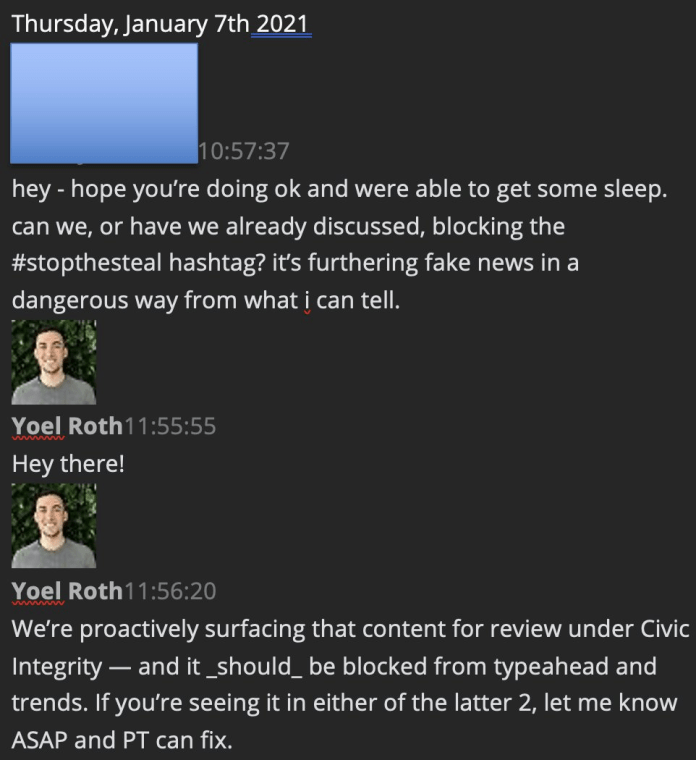
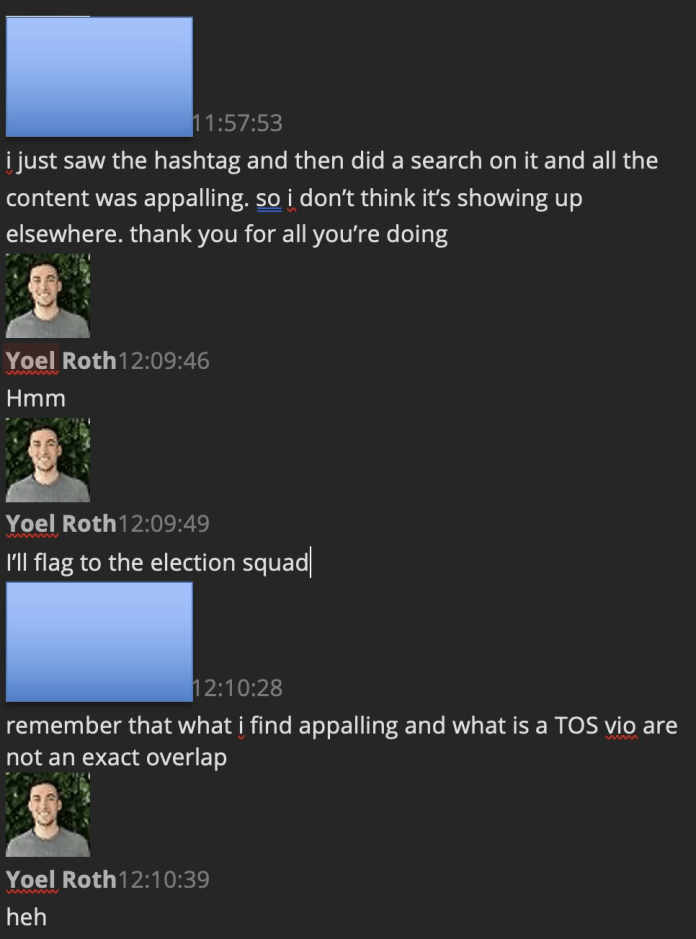
Roth immediately messaged a colleague to ask them to add “stopthesteal” & [QAnon conspiracy term] “kraken” to a blacklist of terms to be deamplified (sic). Roth’s colleague objects that blacklisting “stopthesteal” risks “deamplifying counterspeech” that validates the election.
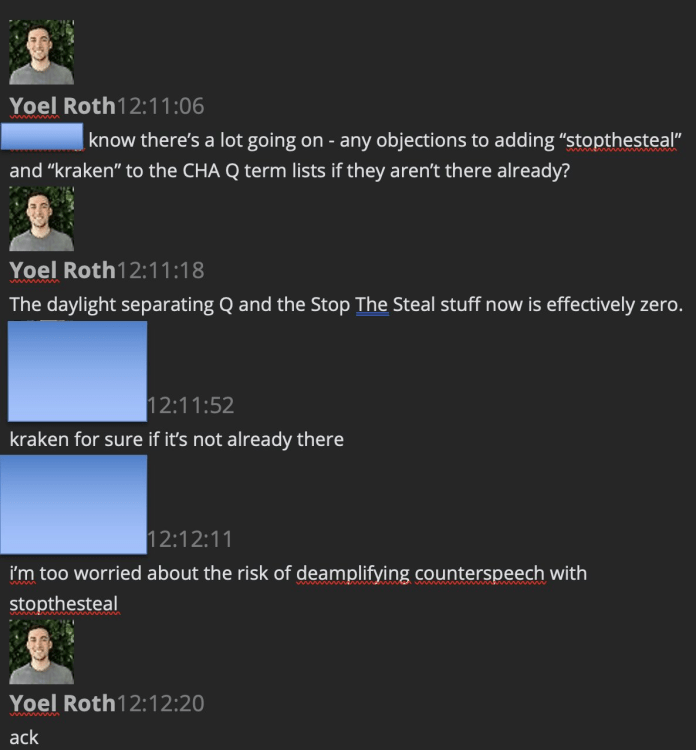
Roth’s colleague notes that “a quick search of top stop the steal tweets and they’re counterspeech”. But they quickly come up with a solution: “deamplify accounts with stopthesteal in the name/profile” since “those are not affiliated with counterspeech”
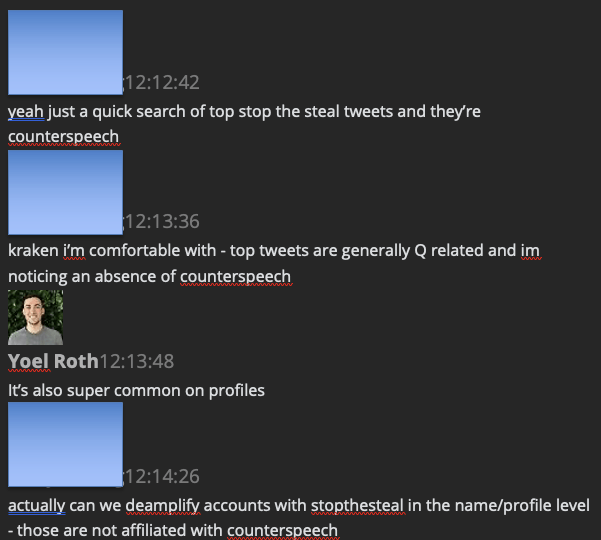
But it turns out that even blacklisting “kraken” is less straightforward than they thought, Shellenberger explains. “That’s because kraken, in addition to being a QAnon conspiracy theory based on the mythical Norwegian sea monster, is also the name of a cryptocurrency exchange, and was thus ‘allowlisted’,” the author says.
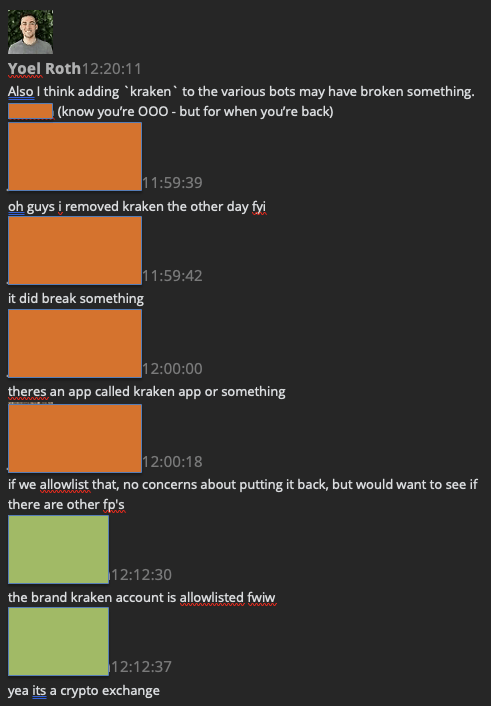
Employees struggle with whether to punish users who share screenshots of Trump’s deleted tweets related to the 6 January Capitol riot: “We should bounce these tweets with a strike given the screenshot violates the policy… they are criticising Trump, so I am a bit hesitant with applying strike to this user”.

What if a user dislikes Trump and (emphasis by Shellenberger) objects to Twitter’s censorship? The tweet still gets deleted. However, “since the intention (emphasis by Shellenberger) is not to deny the election result, no punishing strike is applied,” the author says.
“If there are instances where the intent is unclear please feel free to raise,” an employee is cited as saying with a screenshot larger than the one above.
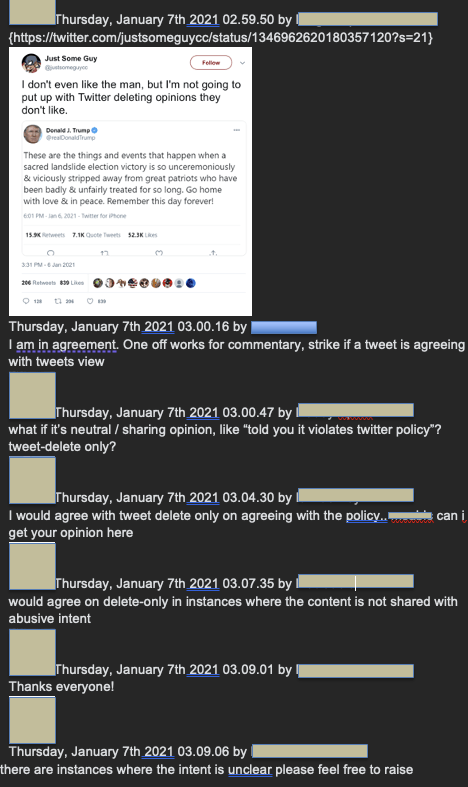
Around noon that day, a confused senior executive in advertising sales sends a DM to Roth, saying, “Jack says: ‘we will permanently suspend [Trump] if our policies are violated after a 12-hour account lock’… what policies is jack talking about?”
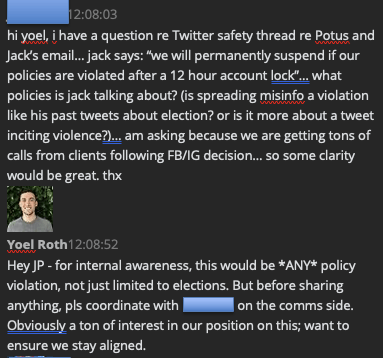
What happens next is essential to understanding how Twitter justified banning Trump, Shellenberger writes and cites a sales executive saying, “Are we dropping the public interest [policy] now…”
Roth says 6 h later: “In this specific case, we’re changing our public interest approach for his account…”
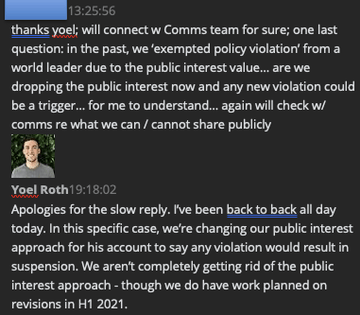
The advertisement executive was referring to Twitter’s policy of “Public-interest exceptions,” which allowed the content of elected officials, even if it violates Twitter rules, “if it directly contributes to understanding or discussion of a matter of public concern.”

Roth then pushed for a permanent suspension of Republican Matt Gaetz even though it “doesn’t quite fit anywhere (duh)”. It was a kind of test case for the rationale for banning Trump, Shellenberger explains, citing, “I’m trying to talk [Twitter’s] safety [team] into… removal as a conspiracy that incites violence.”

At about 2:30 PM that day, communication executives sent a DM to Roth to say they did not want to make a big deal of the QAnon ban to the media because they feared “if we push this it looks we’re trying to offer up something in place of the thing everyone wants,” meaning a Trump ban, Shellenberger shares.

That evening, a Twitter engineer messaged Roth to say, “I feel a lot of debates around exceptions stem from the fact that Trump’s account is not technically different from anybody else’ and yet treated differently due to his personal status, without corresponding Twitter rules..”
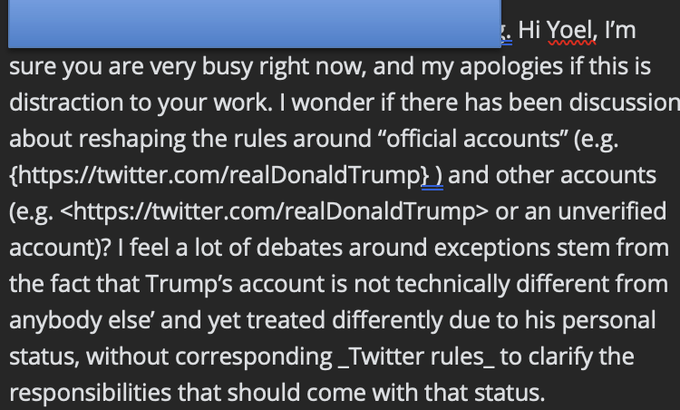
Roth’s response hinted at how Twitter would justify deviating from its longstanding policy. “To put a different spin on it: policy is one part of the system of how Twitter works… we ran into the world changing faster than we were able to either adapt the product or the policy.”
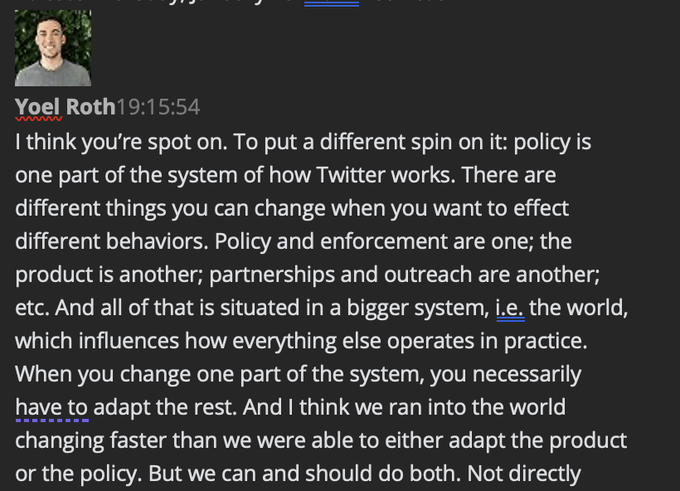
In the evening of 7 January, the same junior employee who expressed an “unpopular opinion” about “ad hoc decisions… that don’t appear rooted in policy,” speaks up one last time before the end of the day, Shellenberger reports, recalling the explanation of “one off”.
Earlier that day, the employee wrote, “My concern is specifically surrounding the unarticulated logic of the decision by FB. That space fills with the idea (conspiracy theory?) that all… internet moguls… sit around like kings casually deciding what people can and cannot see.”
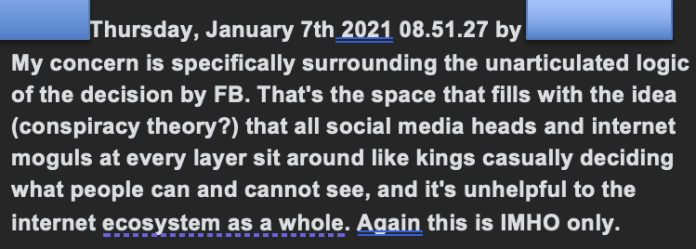
The employee noted later in the day, “And Will Oremus noticed the inconsistency too…,” linking to an article for OneZero at Medium called, “Facebook Chucked Its Own Rulebook to Ban Trump.”
“The underlying problem,” wrote writer Will Oremus, is that “the dominant platforms have always been loath to own up to their subjectivity because it highlights the extraordinary, unfettered power they wield over the global public square and places the responsibility for that power on their own shoulders… So they hide behind an ever-changing rulebook, alternately pointing to it when it’s convenient and shoving it under the nearest rug when it isn’t.”
“Facebook’s suspension of Trump now puts Twitter in an awkward position. If Trump does indeed return to Twitter, the pressure on Twitter will ramp up to find a pretext on which to ban him as well.”
“Indeed,” concluded Shellenberger, “And as Weiss will show tomorrow, that’s exactly what happened.”


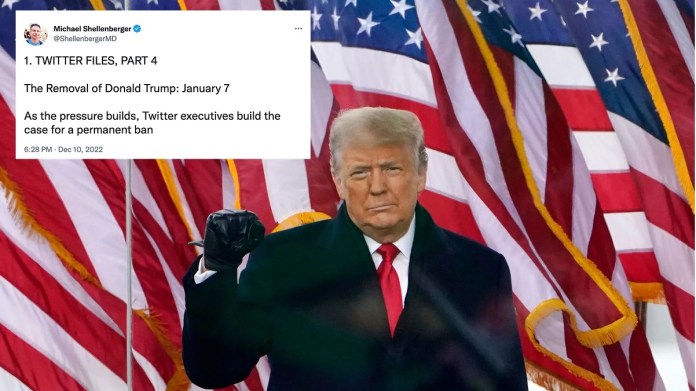

You must log in to post a comment.